If you have a 2-week vacation to China, and eager to discover diverse landscape and distinctive ethnic cultures, we strongly recommend you to take this 15-day best China tour, ranging from the south to north, from east to west. During this 15-day best China tour, you will visit the top destinations of Beijing, Dali, Lijiang, Shangri-La, Kunming and Shanghai. Your adventure will start from the imperial palace in Beijing, followed a best China trip to the place south of colorful clouds Yunnan, and end at the tallest building of China in Shanghai. You will see different ethnic minority culture, solemn royal architecture and modern lifestyle in the megacity all in 15 days. What are you waiting for? Come and join us to this best China tour ever!

Welcome to Beijing! Our 15-day tour starts with the pickup service from the airport to the hotel!
Beijing is a time-honored city with a history of about 3,000 years, which serves as the capital for 850 years and six dynasties of China. It is a cultural hub of an area as immense as China, which brings Beijing as the city that is home to the most UNESCO World Heritage sites than any other city in the world, including the Great Wall, the Forbidden City, the Zhoukoudian Peking Man Site, the Summer Palace, the Temple of Heaven, the Imperial Tombs of the Ming and Qing Dynasties and the Grand Canal. Five out of the seven sites are included in our trip.
As the capital of the People’s Republic of China, Beijing is also a globally influential city, showing the world its vitality and modernity after its host of the 2008 Summer Olympic Games. It is the third most populous city in China and the most populous capital in the world. With a long history as a center of China, Beijing cuisine has integrated culinary traditions from all over China and the Chinese imperial cuisine, developing a set of distinctive dishes which is represented by Peking Roast Duck.
The first site we will visit is the Temple of Heaven. The Temple of Heaven was built for the emperors of the Ming and Qing Dynasties (1368 - 1912) to pray and offer sacrifices to Heaven. It is the largest surviving sacrificial building complex of ancient China, covering an area of about 2.73 million square meters, four times the size of the Forbidden City.
The Temple of Heaven is separated by two altar walls, shaped like the Chinese character “回” (pronounced hui in Chinese). The main buildings include the Circular Mound Altar for holding the rituals of Heaven, the Imperial Vault of Heaven for placing the sacrifice tablets, and the Hall of Prayers for Good Harvests for praying for a good harvest. Considerable restoration work was carried out to the Hall of Prayers for Good Harvests during the reign of Emperor Qianlong (1736-1795) of the Qing Dynasty (1644 - 1912). The Echo Wall, surrounding the Imperial Vault of Heaven, is the landmark of the Temple of Heaven, with a very regular curvature and an extremely smooth surface. For its unique acoustic properties, one person can hear what the other says on the other edge of the wall no matter how lower the voice is.
The Temple of Heaven epitomizes the architectural design and construction of art. The rich woodland surroundings of the Temple of Heaven create an ecological environment that highlights the harmony between humankind and nature.
Tian’anmen Square is our next must-see attraction. Tian’anmen Square, which is the largest city square in the world, is located on the central axis of Beijing city, with 880 meters in length and 500 meters in width. Covering an area of 440,000 square meters, the square can accommodate 1 million people for grand gatherings. Tian’anmen Square was only originally a T-shaped square which is part of the Forbidden City. Only the emperors were allowed to walk through at that time. In 1914, Tian’anmen square was modified by Zhu Qilin and it became a public space, in the modern sense. In 1958, Tian’anmen Square underwent one of the largest expansions in its history to celebrate National Day. The last major reconstruction was carried out in 1976. The northern end of the square is the Tian’anmen Gate Tower, an outstanding symbol of Chinese ancient buildings. Tian’anmen means “divine of king rights to bring peace and stability to the country”. The Tian’anmen Gate Tower is currently the venue for important Chinese celebrations and the foyer where Beijing welcomes guests from all over the world.
The Forbidden City (closed every Monday) will end our morning itinerary. The Forbidden City, the most popular single attraction of China, sees over 10,000 tourists per day. It was built from 1401 to 1426 and was the Chinese emperors’ palace complex at the very center of Beijing city, covering about 178 acres, five times more than Buckingham Palace. As the home of 24 emperors during the Ming and Qing Dynasties, the rectangular Forbidden City encompasses more than 980 buildings and is divided into outside court for conducting major ceremonies and various political activities, and inner court where the emperor and the concubines lived as well as the emperor dealt with routine political affairs. The Forbidden City enjoys a large collection of ancient art treasures, with the richest collection of cultural relics in China. It accounts for one-sixth of the total number of cultural relics in China and is also a world-renowned museum of ancient culture and art. Many of its collections are unparalleled and priceless national treasures. The UNESCO-listed Forbidden City is the largest and most complete group of ancient buildings in China, known as the “Sea of Palaces”. It is probable that most visitors have already glanced a little about its magnificence in the famous movie The Last Emperor.
The next is a mouth-watering meal greeting us! Our schedule goes to the Summer Palace in the afternoon. The Summer Palace was built in 1750 by Qianlong Emperor, and reconstructed in 1888 as a royal summer resort. The Summer Palace is known as the “the Museum of Royal Gardens”, a representative of the peak period of Chinese garden art. The year 1998 saw the Palace listed in UNESCO World Heritage Sites. With exquisite pavilions, gardens, and walkways, the palace served as the center for Empress Dowager Cixi to handle political affairs during her later years.
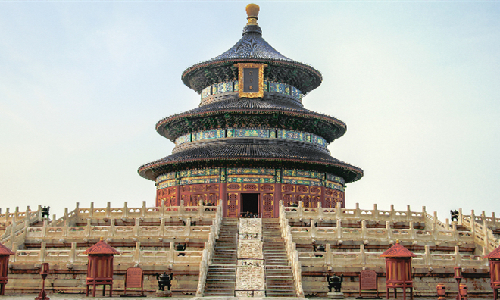

Our third-day itinerary begins with the Ding Tombs of the Ming Tombs. The Ding Tomb is far from the center of Beijing, about 50 kilometers to its northwest. So, it takes about one and a half hours, after breakfast for us to get there. The Ming Tombs, or the Ming Thirteen Tombs, are the burial complexes of the thirteen emperors of the Ming Dynasty (1368 - 1644). As the only tomb of a Ming Dynasty emperor that has been excavated, the Ding Tomb is one of the three largest of the thirteen tombs, occupying a surface area of approximately 45 acres. It is the mausoleum of the thirteenth emperor, Emperor Wanli, together with his two empresses.
The Ding Tomb saw its first construction in 1584 and took six years to complete. The tomb sat idle for 30 years as Emperor Wanli was just aged 28 when it was finished. The general layout of the tomb is square-shaped in its front and is round-shaped at its back, representing the traditional philosophical concept of “round sky and square earth”. The main buildings of the Ding Tomb are located on a central axis, with the underground palace being the main part of the whole tomb. In 1959 the Ding Tomb Museum was opened to the public.
We will enjoy our lunch after visiting the Ding Tomb, and our visit to Beijing will end with the Mutianyu Great Wall. As an important section of the Great Wall of China, the Mutianyu Great Wall was reconstructed in 1368 by Xu Da, a great general of the Ming Dynasty. With a total length of 5,400 meters, it is the longest one in China at present. Covered by mountains and forests, the vegetation coverage rate of the Mutianyu Great Wall is over 90%. Hence, it is praised as “the most beautiful landscape section of the Great Wall”. Many foreign heads of state, such as former British Prime Minister Major and former U.S. President Clinton, have visited the Mutianyu Great Wall. Cable cars are provided in the scenic spot so that visitors can take the cars to appreciate the whole stunning Mutianyu Great Wall.
After a whole-day visit, we will get back to the hotel for rest and we will start a new journey in Dali the next day!


 Dali
Dali On the fourth day, we will have an early breakfast and take the estimated flight CA1499 (06:55/11:10) to Dali, Yunnan Province. Our trip starts with the Dali Ancient Town. The Dali Ancient Town has a history dating back to the Tang Dynasty (618 - 907), which is a historic place with the rich culture of Chinese ethnic minorities. It was the political, economic, and cultural center of Yunnan for more than 500 years during the Tang and Song Dynasties.
Under the Cangshan Mountains and on the shore of the Erhai Lake, the town was in a square-shaped structure, covering an area of 3 square kilometers. The houses in the town were characterized by the Bai people residential style. Most of the streets, paved with stone slabs, have streams with clear water flowing from the Cangshan Mountains, the top of which is covered by snow all seasons.
Dali Ancient Town, with mild weather and small annual temperature difference, is relatively less crowded and more comfortable among attractions of Lijiang. Visitors can wander around the town where carries the history, religious and ethnic culture of Dali. The town was listed as the famous historical and cultural city in China. It represents the centerpiece of Dali tourism.
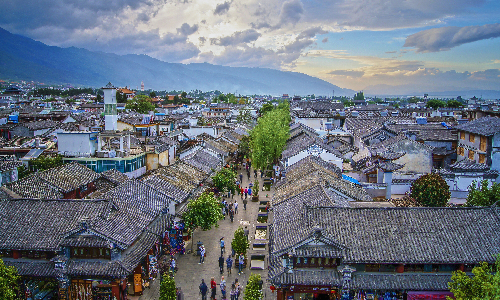
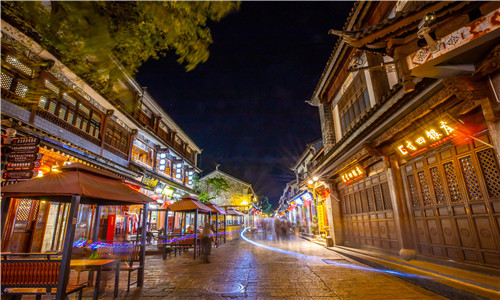
On the fifth day, we will visit Erhai Lake after breakfast. The origin of the name “Erhai” dates back from the Han Dynasty to the Tang Dynasty (202 BC - 907 AD). “Erhai” is translated, literally, as the “ear sea” in Chinese. As the lake is in the ear shape and is as large as a sea, it got such a name. The lake used to be part of a royal deer ranch for the Nanzhao Kingdom, which as a local authority existed during the Tang Dynasty. The lake occupies an area of about 250 square kilometers and it is as deep as 21.5 meters, representing the seventh freshwater lake in China.
Faced the west shore of the Erhai Lake, the Three Pagodas of Chongsheng Monastery is our next destination in the morning. The monastery is located about one kilometer north of the ancient city of Dali. Credited as “Buddhist Capital”, the monastery served as a royal temple of the local regime Kingdom of Nanzhao (738 - 902) and Kingdom of Dali (937 - 1253) more than a thousand years ago, and nine out of 22 kings of Dali Kingdom have become monks at Chongsheng Monastery.
The main temples of the monastery were burned down during the Qing Dynasty (1644 - 1912) and only three pagodas remained intact. The Three Pagodas of Chongsheng Monastery is the symbol of Dali Ancient City. As its name implies, it is an ensemble of three independent pagodas arranged on an equilateral triangle. The mother pagoda, named Qianxun Pagoda, is shaped in a square and was built in the Tang Dynasty, with 69.13 meters in height and 16 floors. It is one of the tallest surviving Tang-dynasty-style pagodas in China. The other two sibling pagodas were built in the Song Dynasty (960 - 1279), with 42.19 meters in height and 10 floors. Three pagodas are virtually straight in a manner somewhat reminiscent of swords plugging into the sky. Many Buddhist sculptures made of wood, silver, and crystal, Buddhist realms and readings, as well as various medical ingredients were found in the Qianxun Pagoda, demonstrating the ancient history of Dali.
That is the end of our travel in the morning. Lunch is waiting for us!
After having a break, we will visit Xizhou Ancient Town. Xizhou Ancient Town is a huge museum of residential architecture that gathers hundreds of distinctive Bai-style buildings from the Ming Dynasty to contemporary periods. The Ancient Town leans against the Cangshan Mountains in the west and the Erhai Lake in the east, located 18 kilometers north of Dali Ancient Town. The Town has been historically vital as a trading post along the Tea Horse Road. The town consists of 13 small villages with a combined population estimated at 2,500. Most of them are Bai people who practice a matriarchal structure of society. Except for the exquisite architecture and elegant sightseeing, what can feast visitors’ eyes also lies in Bai women who still dress up a distinctive headdress and costume. You also can wander along the time-honored town square and have a direct conversation with history. It would be inspiring. Ending with Xizhou Ancient Town, we will provide the included service for you to send you back to your hotel.
Option:
The Ancient Town will bring you famous local dishes, Xizhou Baba and Three-course Tea. You can make a Tie-dye, a technique listed as a national intangible cultural heritage, by yourself.

 Lijiang
Lijiang The next schedule is set from Dali to Lijiang by bus after breakfast. Lijiang lies on the north side of Dali and is about 180 kilometers within 3 hours. But we need to spend more than 3 hours because another worthy-seeing attraction is on our way, Shaxi Ancient Town. By the way, lunch is also prepared for you.
Shaxi Ancient Town was a historic market town, which saw its first construction in the Spring and Autumn and the Warring States (770 BC - 221 BC), its emergence as a trading point for Tea Horse Road during the Tang Dynasty (618 - 907) and its heyday during the Ming and Qing Dynasties. The town is literally antique in which remain the most ancient architectural features, such as ancient temples, theatres, stores, lanes, and hundred-year-old trees, etc. Therefore, it was selected to be on the World Monuments Watch List of 100 Most Endangered Sites in 2001 and listed in the 101 world's endangered buildings to be protected in 2002 by World Monuments Fund.
The heart of Shaxi Ancient Town is Sideng Street, a time capsule that remains a fascinating window onto a China that has long disappeared in the rest of the country. Xingjiao Temple, the core of Sideng Street, originally was constructed as an Azhali Buddhist shrine in 1415, during the Ming Dynasty (1368 - 1644).
After visiting the Shaxi Ancient Town, we will go back to the hotel in Lijiang.
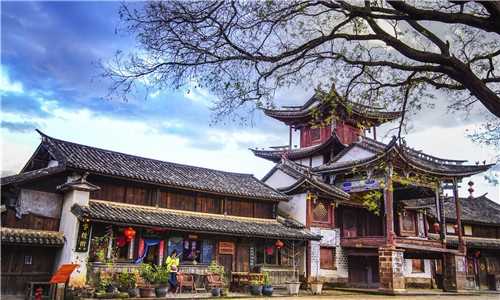

Time flies to the seventh day. The schedule starts with the magnificent Jade Dragon Snow Mountain, or Yulong Snow Mountain after breakfast. The distance from Lijiang to the Jade Dragon Snow Mountain is about 20 kilometers, nearly half an hour by car.
The Jade Dragon Snow Mountain is the symbol of Lijiang. The mountain range has 13 peaks, among which the highest summit is Shanzidou Peak reaching 5,596 meters above sea level. As it is surrounded by snow, clouds, and fog all the time, the mountain looks like a lying jade-colored dragon from afar. This explains why it is called Jade Dragon. The mountain massif is a sublime mountain of the Naxi people, which is the embodiment of the Sanduo God who bravely protects the Naxi people in local myths. Therefore, the mountain plays as a heroic image-carrier in the Naxi legends and folklores. Thanks to its high altitude, the mountain greets you with the marvelous alpine snow and glacier, the striking gorge waterfalls, the sky-covering primeval forests, and endless alpine meadows. In addition to hiking, sightseeing, and exploring, a deeper understanding of the Naxi culture is also a good option for you. To say the least, it would be your life regret of missing the Jade Dragon Snow Mountain if you travel to Lijiang. After having fun with the Snow Mountain, we will take a rest for lunch. Our afternoon trip is to visit Yuhu Village and Lijiang Ancient Town.
Yuhu Village is located in the northwest of the Jade Dragon Snow Mountain, about 15 kilometers from the downtown of Lijiang Ancient Town. The village is also called “Wuluken” in the Naxi language which means the foot of the snow mountain. A river with a length of 200 meters and a width of 40 meters surrounds the village. “Yuhu” means “Jade Lake”, an artificial lake created by the Mu Family, a local ruler before the Ming Dynasty. And the earliest inhabitants of Yuhu Village were the people who kept deer for the Mu Family. The massive mountain range, the clean sky, the white clouds, and the surrounding green plants are reflected in the Yuhu River, forming a picturesque view “Yuhu Reflection”, the top of the “Jade Dragon Twelve Scenery”. Horse plays an important role in the village as the main transportation means in ancient times and as the main tourist program at present, and the service of touring the village on the horseback is provided. Moreover, Yuzhuqingtian (Jade Pillar Supporting the Sky) Scenic Resort is a famous tourist spot in the west of Yuhu Village. Joseph Rock, an American explorer, writer, and photographer for the National Geographic Magazine and Harvard University, lived in the village to study and promote the Naxi culture for more than 20 years. To commemorate his contribution, his house is preserved as a small museum displaying his items and documents he had used.
Our next trip goes to the popular Lijiang Ancient Town. Lijiang Ancient Town, also known as Dayan Town, can date back to over 1,000 years ago. More than a national historical and cultural city, the town is listed as a UNESCO World Heritage Site. Lijiang Ancient Town is the only old town that does not have city walls in China. It was said that the reason is to avert something inauspicious. The surname of the city ruler is Mu (Chinese “木”). And once the square city walls were built, the Mu (木) would be like “Kun (困)”, meaning “trouble” or “plight”. The famous attractions of the Lijiang Ancient Town include Sifang Street, a representative of the town, and the Mufu, a building of the city ruler Mu family as the core of Lijiang over hundreds of years. Also, it is famous for its orderly system of waterways and bridges, with a total of about 354 bridges. Its architecture is noteworthy for the blending of elements from several cultures that have come together over many centuries.
The Lijiang Ancient Town is the essence of Naxi culture and has remained a historical style since the Song Dynasty. The vivid urban space, the vigorous water system, the harmonious building complexes, the comfortable residences of appropriate size, the pleasant environment, and the folk art of unique style combine to form an outstanding example of human habitat.
Our seventh-day itinerary is coming to an end. The driver will take you back to the hotel.


After having breakfast, we will set to visit Baisha Village and Baisha Murals. Located about 10 kilometers north of Lijiang City, Baisha Village was built in the early Tang Dynasty (618 - 907) and the village served as the political, economic, and cultural center of Lijiang before 1638. The village has become a religious center during the Ming Dynasty and now serves as an ideal haunt for travelers who want to engage in learning the Naxi culture and ancient Buddhist history.
The famous Baisha Mural, only 55 pieces preserved in different temples, is a creative production of the great opening of the Naxi society in the Ming Dynasty. It incorporates the different religious paintings that reflect famous stories from Buddhism, Lamaism, Taoism, and local Naxi Dongba religion by the artists of Naxi, Bai, and other ethnic minorities, meaning a mixture of ethnic styles. Even as a part of the Lijiang World Heritage Site, the village is less crowded that you do not have to force your way through throngs of tourists. And that offers you a glance at the authentic life of Naxi people, man-made tie-dye artwork and traditional embroidery, and so on.
Lunch is prepared for you before we start our visit to Dongba Culture Museum and Black Dragon Pool Park.
The Dongba Culture Museum (closed on Mondays in the first and third week of every month), located in the Black Dragon Pool Park, centers on the Dongba culture of the Naxi people. The museum, in the style of a traditional Naxi courtyard house, was established in 1984 to better protect, research, and develop the Dongba Culture. Dongba culture inclusively refers to the written language, the only known hieroglyphic writing system still in use, and sculptures related to the Dongba religion. The museum has more than 24,000 Dongba cultural and historical relics and offers the “Dongba Culture Exhibition”, attracting more than 100,000 visitors each year.
With only about 30 Naxi people left in the world who can still write Dongba script, so you are recommended to head to the museum as soon as possible or risk missing out on this mysterious culture.
About 300 meters from the back entrance of the museum we will head to Black Dragon Pool. The Black Dragon Pool Park is also known as Yuquan Park (Jade Spring Park) where the most renowned site is Black Dragon Pool. The pool was firstly built in 1737 during the Qing dynasty (1636 - 1912). Folklore says there is the king of the black dragon, a traditional god of China, lurking under the lake, so it got such a name.
Its white marble bridge offers visitors views of the Jade Dragon Snow Mountain. The pool, with the surrounding attractions such as the Moon-Embracing Pavilion and the Five Phoenix Temple, shines with each other.
Having finished visiting the Park, our guider and driver will send you back to the hotel.


 Shangri-La
Shangri-La Before we take the bus to Shangri-La, we will have breakfast and then drive about 1 hour to visit the First Bend of Yangtze River which is located 50 kilometers west of the Lijiang Ancient Town. The Yangtze River from the Qinghai-Tibet Plateau rushes to Yunnan Province and passes through the deep valleys of the Hengduan Mountains together with the Lancang and Nujiang Rivers. When reaching the village of Shashongbi in Zhongdian County, the Yangtze River is blocked by the cliffs so that it has to make a sharp turn of more than 100 degrees from southeast to the northeast, forming a “V”-shaped bend, and thus getting the name as “the First Bend of the Yangtze River”.
About the origin of the bend, a widely spread folklore story is followed. The three sisters of the Nujiang River, the Lancang River, and the Jinsha River (namely the Yangtze River) traveled together. But a dispute occurred on their halfway. The two elder sisters stubbornly went south while the youngest dreamed to the east, a sun-rising direction, to find light and love. Therefore, the youngest sister said goodbye to the two sisters and resolutely turned east, and thereby forming the bend.
After experiencing the amazement of the Bend, you will be picked up and sent to the next destination: The Tiger Leaping Gorge. We will drive about 1 hour to the 55 kilometers north of the First Bend of Yangtze River. Legend says that the name comes from a fierce tiger chased by a hunter. The tiger ran through the gorge until it reached the narrowest point. Trapped between the hunter and the rushing river at the base of the gorge, the tiger leaped the 25 meters gap across the gorge, escaping the hunter.
The gorge is carved out by the Jinsha River, a tributary of the massive Yangtze River. A height difference of 3,790 meters and a total length of 16 kilometers bring the gorge the deepest river canyon in China. The Tiger Leaping Gorge is a part of the Three Parallel Rivers of Yunnan Protected Areas, a UNESCO World Heritage Site. Its steep limestone ridges and vertiginous cliffs have drawn thousands of overseas adventure seekers every year. It was once named “one of the most beautiful gorges in China” by China National Geographic Magazine.
After experiencing the amazement of the Tiger Leaping Gorge, you will be picked up and sent to the next destination: Shangri-La! Shangri-La is located in the northwest of the Lijiang Ancient Town, with nearly 80 kilometers and about 2 hours on the bus.
Shangri-La, ever named Zhongdian County, is a county-level city in the location of Diqing Tibet Autonomous Prefecture. The name of Shangri-La is from the Tibetan language, which means “the sun and moon in the heart”. More interestingly, its name is the same as a fictional place described in the novel Lost Horizon by British author James Hilton in 1933. In the novel, Hilton describes Shangri-La as a mystical, tranquil, and harmonious earthly paradise isolated from the world. The real Shangri-La city lives up to the fictional one under the description by Hilton. The lofty snow mountains, mirror-like lakes, clearing sky, endless grass pastures, and biological diversity will purify your mind.
That is the end of our ninth day!We will directly go to the hotel once we arrived in Shangri-La.
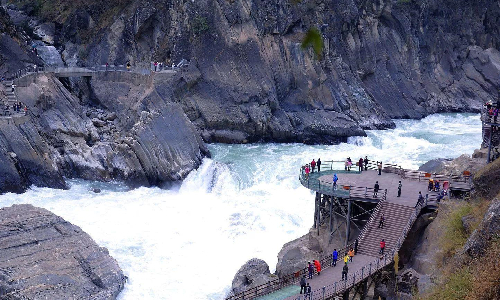

Today we will visit Songzanlin Monastery in the morning. The Songzanlin Monastery, about 5 KM from the center of Shangri-La city, is the largest Tibetan Buddhist monastery in Yunnan Province. It was firstly established in 1679 and completed in 1681, and its name was given by the Fifth Dalai Lama.
It was constructed like an ancient fortress, integrating the Tibetan and Han Chinese architectural styles, with a lot of religious artifacts and precious cultural relics boasted in the Monastery. So, it is praised as the “Tibetan Art Museum”. Because of its pivotal role in the entire Tibetan region and its castle shape, the Songzanlin Monastery was also credited as the “little Potala Place”.
The monastery has two major lamasery buildings, Zhacang and Jikang. Zhacang was built in Tibetan style with a gilded copper roof, looking like the Potala Monastery in Lhasa far away. Jikang is a complex in the Han Chinese style. The monastery can accommodate 700 monks in 200 associated houses. Visitors can get an in-depth understanding of the routine life of the monks. It would be a wonderful trip.
We will visit Pudacuo National Park after lunch.
The Pudacuo National Park, also named Potatso National Park, is a national-level park located in Shangri-La County, with 1,300 square kilometers, about three-quarters of the size of New York City. The name “Pudacuo” refers to “Lake Boat”, a boat with the help of the God ferrying people from sufferings. It is composed of three parts: Militang Pasture, Bitahai Nature Reserve, an internationally important wetland, and Shudu Lake Scenic Area, a part of the Three Parallel Rivers of Yunnan Protected Area.
Pudacuo is recognized as the “tears of Shangri-La”. Due to its rich ecological resources and well-preserved original ecological environment, Pudacuo is notable for the first national-level park in China. Pudacuo is a well-preserved ecological system that has marsh, lakes, virgin forests, brooks, springs, and rare fauna and flora resources. From any perspective, Pudacuo qualifies as a natural wonderland and visitors would be comforted by it.
That is the end of our trip to Shangri-La.

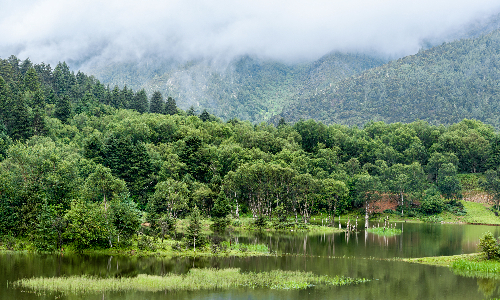
 Kunming
Kunming You will take the estimated flight MU5934 13:00/14:05 from Shangri-La to Kunming after breakfast. Our guide will send you to the airport. Once you arrive in Kunming, a pick-up service is also included to send you to the hotel in Kunming.
On the morning of the 12th day, we will visit the Stone Forest. It is located in Shilin Yi Autonomous County, northwest of Kunming. The distance is about 85 kilometers and can be reached within two hours. The Stone Forest, or Shilin, is a set of limestone formations caused by the weathering of limestone. It was listed as “UNESCO Global Geopark” in 2004 and selected as “World Natural Heritage” in 2007 as an important part of “Southern China Karst”.
Once a shallow sea some 270 million years ago, the Stone Forest evolved into a typical karst landscape through millions of years of geological changes. The tall rocks seem to emerge from the ground just like stalagmites, or many resembling petrified trees, bringing people an illusion of a forest made of stone. The Stone Forest covers an area of 400 square kilometers and consists of five areas. The five areas are dotted with various stone peaks in the shape of swords, columns, towers, mushrooms, and others in balance or irregular.
The Yi people, who have lived in the Shilin area for generations, have developed a national culture represented by the “Ashima”. And the Stone Forest is also known as the birthplace of Ashima, a girl who turned into a stone in the forest after failing to marry her lover, in the legend of the Yi people. Moreover, “Ashima” is also named as a long poem of the Yi people, which was selected as the first batch of the national intangible cultural heritage of China.
Before we visit Green Lake Park in the afternoon, we will enjoy a delicious lunch.
The Green Lake Park, with an area of 21 hectares, was established in the 20th century and is located in the downtown area of Kunming Province. It features the weeping willows and the green and clear water, so it was hailed as “a jade of Kunming”. Two long dikes divided the lake into five scenic spots among which the main spot is prevailed by Qing Dynasty buildings.
Every winter would witness a large number of seagulls from Siberia to Kunming, most of them roosting in the Green Lake. As a result, the most common scene in the park is that most residents flock to the park to feed various birds in spring and winter. Imagine a picture that you walk around the lake and feed these little elves. How lovable and harmonious!
After visiting, we will head to the hotel overnight.
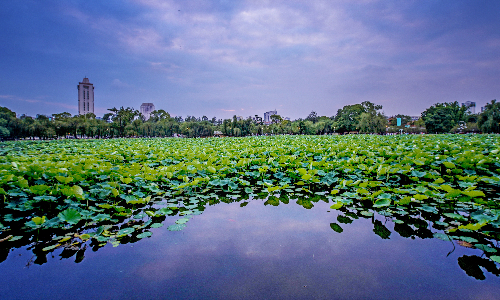
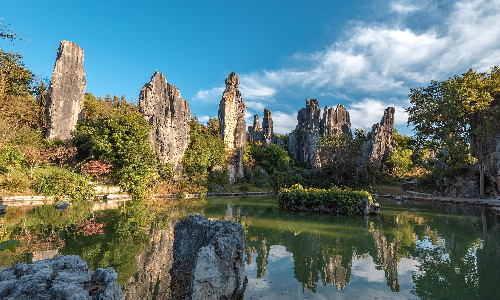
 Shanghai
Shanghai On the 13th day, we will head to Shanghai, the most developed city of China, by the estimated flight KY8221 14:30/18:00. Attentive pick-up and drop-off services are included so that you just carefully pack your luggage and necessary identification certificates, and we will take care of the rest.
The Jade Buddha Temple is the first attraction of our journey in Shanghai. Situated in the downtown of Shanghai, Jade Buddha Temple is described as “a piece of pure land in the bustling area”. The temple is named after two Jade Buddha sculptures, a sitting Buddha with 1.95 meters in height and 3 tons in weight, and a smaller reclining Buddha representing the Buddha’s nirvana. The two sculptures were imported to Shanghai by Master Huigen from Myanmar.
Occupying an area of about 11.6 acres, the temple was founded in 1882 and its architecture imitated the temple style in the Song Dynasty. There are three main halls on the central axis, with subsidiary buildings symmetrically distributed on the east and west sides. As one of the top ten tourist attractions in Shanghai, the temple was visited by almost all foreign government dignitaries and famous people, such as Nancy Reagan, the former First Lady of United States, Pierre Maurois, former Prime Minister of France, and Ninian Stephen, Governor-General of Australia, and his wife.
Yu Garden (closed every Monday) in the northeast of the Old City of Shanghai, is a typically classical Chinese garden with an area of approximately 2 hectares and has become a famous tourist attraction in Shanghai. The garden was first built in 1559 during the Ming Dynasty by Pan Yunduan to comfort his father. That also explains its name “Yu”, which means “peace” and “pleasant” in Chinese. The centerpiece of the garden is Yulinglong, or Exquisite Jade Rock, 3 meters high, 1.5 meters wide, and 80 centimeters thick.
Yu Garden is divided into six main parts by “dragon walls”, iconic rolling gray-tiled ridges of scales terminating with an ornate head of a dragon. With exquisite pavilions, terraces, and multistory towers, as well as elegant aesthetics, the garden was hailed as “the crown of beauty in Southeast China”. Foreign dignitaries including the Queen of England ever visited the garden. Yu Garden abuts the Yu Garden Old Streets which offer local yummy snacks and distinctive souvenirs.
Our trip goes to Shanghai Tower in the afternoon after lunch.
Shanghai Tower will see the end of our trip. Yes, the next, also the final destination, is Shanghai Tower after lunch. Shanghai Tower is a mega tall skyscraper in Lujiazui with 128 stories and 632 meters, firstly built in 2008 and finished in 2016. As the winner of the Tien-yow Jeme Civil Engineering Prize of 2018, Shanghai Tower represents the world’s second-highest skyscraper and tallest green building of the world.
The tower also has the second biggest observation deck in the world, Top of Shanghai Observatory, which is on the 118th and 119th floor. It is in a spiraling appearance and can be divided into office, hotel, commercial, exhibition, tourism, entertainment, and other functional areas, just like a small city. It also has the fastest elevator in the world, taking only 55 seconds to reach the observation deck on the 118th floor at 546m off the ground.
On the 118th and 119th floor, visitors are offered a fantastic bird-view of Shanghai: stepping on the Oriental Pearl and Shanghai World Financial Center, gazing at the World Expo Park, City God Temple, and Hongqiao Airport in the distance, and seeing the Suzhou River and Huangpu River winding together into the East China Sea. You will understand the modernity and amazement of Shanghai. It must be impressive!
After the tour, we will drive you back to the hotel.
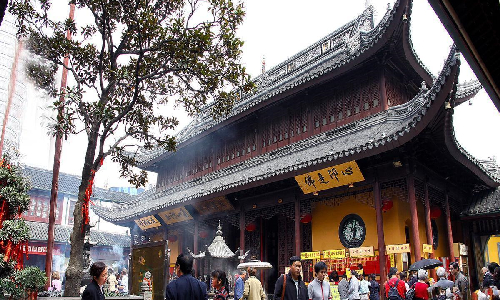

The schedule of the last day goes to the same as before. After breakfast, our guide and driver will send you to the airport according to your flight, and then we will help you deal with all of the check-in steps until you smoothly step into the security checkpoint.
This concludes our 15-day custom trip. During the 15 days, our journey covers a wide variety of landscapes from north to south and west to east. We also provide the careful and gentle service that you need. It will be a wonderful and relaxing journey!
Author: Siqi Chen
Proofreader: Lexie Jia
| City | Five Star hotel list | Four Star hotel list |
|---|---|---|
| Beijing | Sunworld Dynasty Hotel Beijing Wangfujing | Sunworld Hotel Wangfujing |
| Dali | The One Hotels & Resorts | Landscape Hotel |
| Lijiang | Wonderport International Hotel | Lijiang Wangfu Hotel |
| Shangri-La | Paradise Hotel | Ri Yue Xing Cheng Hotel |
| Kunming | Grand Park Kunming | UChoice Hotel |
| Shanghai | Ocean Hotel Shanghai | Courtyard by Marriott Shanghai Central |
 |
![]() About your child or infant, please contact us for a discounted price.
About your child or infant, please contact us for a discounted price.



We started with a few days in Beijing & ended in Shanghai, from where we visited the Forbidden City and Great Wall. In between we visited Terra Cotta Warriors Museum, Panda Base, Shanghai Disneyland.

We had a wonderful holiday in China which will remain long in the memory. China is a breathtakingly beautiful country full of splendid temples and palaces, mountains and rivers, peaceful rural scenes and bustling shopping streets.
 QUICK ENQUIRY
QUICK ENQUIRY